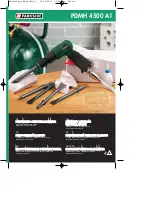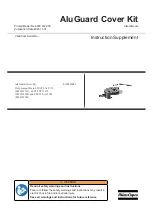
18
| English
This dust extractor is started up automatically when the
power tool is switched on.
The dust extractor must be suitable for the material being
worked.
When extracting dry dust or dust that is especially detri-
mental to health or carcinogenic, use a special dust ex-
tractor.
Operation
u
Pull the plug out of the socket before carrying out any
work on the power tool.
Operating modes
Setting the cutting depth (see figures B–C)
u
Adapt the cutting depth to the thickness of the work-
piece
. A space of less than the height of one full tooth
should be visible under the workpiece.
Turn the cutting depth indicator
(8)
to the bottom position
➊
for sawing without a guide rail, or to the top position
➋
for
sawing with a guide rail.
Push the slider
(27)
to set the required cutting depth (ma-
terial thi tooth height of the saw blade) on the cut-
ting depth scale
(6)
.
Adjusting the mitre/bevel angle
Place the power tool on a level surface, so that the base
plate
(7)
is fully supported.
Loosen the wing bolts
(11)
and
(17)
. Swivel the saw to the
side. Set the required mitre/bevel angle on the scale
(9)
.
Tighten the front wing bolt
(11)
or the rear wing bolt
(17)
.
Then tighten the wing bolt on the opposite side.
Note:
Do
not exert any force on the auxiliary handle
(4)
or the saw it-
self. If this is not adhered to, different mitre/bevel angles
can be set unintentionally with the wing bolts
(11)
and
(17)
.
This means that the base plate
(7)
will then no longer lay flat
on the surface of the FSN guide rail.
If you tighten both wing bolts at the same time, it may be ne-
cessary to support the saw from the bottom of the auxiliary
handle
(4)
. When doing this, do not exert any force on the
auxiliary handle
(4)
or the saw itself to prevent different set-
tings from being implemented.
If the settings have nonetheless turned out to be different,
loosen both wing bolts
(11)
and
(17)
again. Then set the
mitre/bevel angle again as described previously.
The saw can be set to a mitre/bevel angle of -1° or +47°. To
do this, when swivelling, also press the button
(16)
for a
mitre/bevel angle of -1° or the button
(12)
for a mitre/bevel
angle of +47°.
Note:
When making mitre cuts, the cutting depth is less than
the value shown on the cutting depth scale
(6)
.
Cut marks (see figure D)
The 0° cut mark
(32)
indicates the position of the saw blade
when making a right-angled cut. The 45° cut mark
(33)
indic-
ates the position of the saw blade when making a 45° cut –
when used without a guide rail.
Start-up
u
Pay attention to the mains voltage. The voltage of the
power source must match the voltage specified on the
rating plate of the power tool. Power tools marked
with 230 V can also be operated with 220 V.
u
Products that are only sold in AUS and NZ:
Use a resid-
ual current device (RCD) with a nominal residual current
of 30 mA or less.
Switching on/off
To
start
the power tool, first press the lock-off switch
(2)
,
then
press and hold the on/off switch
(1)
.
Pressing the lock-off switch
(2)
also unlocks the plunge func-
tion and allows the power tool to be pushed down. This
causes the application tool to plunge into the workpiece.
Raising the power tool causes it to spring back into the start-
ing position and the plunge function locks again.
To
switch off
the power tool, release the on/off switch
(1)
.
Note:
For safety reasons, the on/off switch
(1)
cannot be
locked; it must remain pressed during the entire operation.
Starting current limitation
The electronic starting current limitation feature restricts the
power of the power tool when it is switched on and enables
operation using a 16 A fuse.
Constant electronic control
The Constant Electronic keeps the speed at no load and un-
der load virtually consistent, guaranteeing uniform perform-
ance.
Speed preselection
You can preselect the required speed using the thumbwheel
for speed preselection
(24)
, even during operation.
The required speed depends on the saw blade used and the
material being worked on (see the saw blade overview at the
end of these operating instructions). This will prevent the
saw teeth overheating when sawing.
Practical advice
Protect saw blades against shock and impact.
Guide the power tool evenly, pushing it gently in the cutting
direction. Applying too much pressure to the power tool
when moving it in the cutting direction significantly reduces
the service life of the application tools and can damage the
power tool.
The sawing performance and the quality of the cut essen-
tially depend on the condition and the tooth shape of the
saw blade. This is why you should only use sharp saw blades
that are suitable for the material being machined.
Sawing wood
Choosing the right saw blade depends on the wood type,
wood quality and whether cuts with or against the grain are
required.
Making cuts in spruce with the grain produces long, spiral-
shaped chips.
Beech and oak dust is especially detrimental to health.
Therefore, work only with dust extraction.
1 609 92A 5H4 | (19.03.2020)
Bosch Power Tools
















































